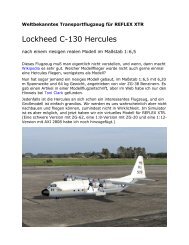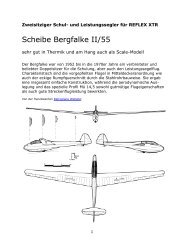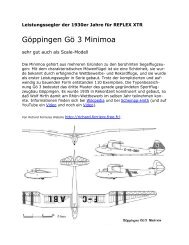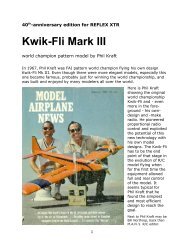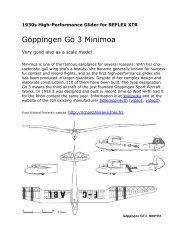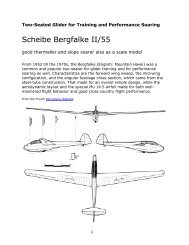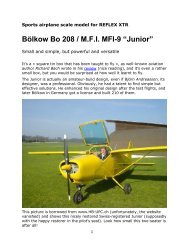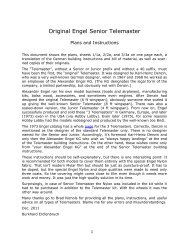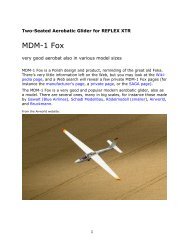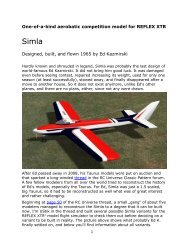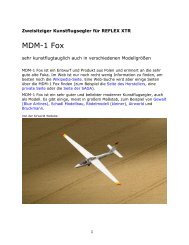Das Ugly Stik for REFLEX XTR
Das Ugly Stik for REFLEX XTR
Das Ugly Stik for REFLEX XTR
- No tags were found...
Create successful ePaper yourself
Turn your PDF publications into a flip-book with our unique Google optimized e-Paper software.
40 th -anniversary edition <strong>for</strong> <strong>REFLEX</strong> <strong>XTR</strong> <strong>Das</strong> <strong>Ugly</strong> <strong>Stik</strong>Lyman Slack mentions the <strong>Ugly</strong> <strong>Stik</strong> two times on his Web page because hebuilt it two times. Quote:» <strong>Ugly</strong> <strong>Stik</strong> trivia: Did you know Phil Kraft had his plans <strong>for</strong> his first <strong>Ugly</strong> <strong>Stik</strong>published in GRID LEAKS magazine back in May/June '66? The plans show aVeco .45 up front surrounded by a round cowl! It also had wheel brakes, apilot, and a gun. «The publication is confirmed in the Vintage R/C Society’s Eligible AircraftListing at page 3.There was a discussion about history of “Classic Pattern” at RC Universe withseveral nice and interesting stories told, especially about four year old ChipHyde flying an <strong>Ugly</strong> <strong>Stik</strong> (posts #10 and #41).Ed Moorman recommended different models <strong>for</strong> beginners at his (nowextinct) Web page and explicitly recommended a stick type even though orjust because it may seem antiquated. Quote:» Phil Kraft's original <strong>Ugly</strong> <strong>Stik</strong>, (from the 60's expression, "It looks like itwas hit with an ugly stick") has to be the most copied and cloned RC planeever. It has to fly well or no one would buy the thing! Any of the "Stick" typeplanes, Big Stick, Sweet Stick, Little Stick, Middle Stick, Joss Stick, <strong>Ugly</strong>Stick, Super Stick, would be a great flier. They can change their spots frommild to wild depending on the engine and control set-up. You can learn to flyon one and then you can change to a larger engine and do anything youwant and still land like a trainer. I like them built without dihedral and with a.60 in the 40-sized version. The trouble with recommending a Stick is theyhave no pizzaz and most have gone out of production. «People may think differently about “Uncle Willie” and his website. Butundoubtedly one of his merits is to present images of the original Jensenplans on one of his Web pages (see here now). These were of paramountimportance <strong>for</strong> this project as they made it at all possible to render themodel in <strong>REFLEX</strong>. And his characterization is well to the point:» Ever since the legendary Phil Kraft designed the <strong>Das</strong> <strong>Ugly</strong> <strong>Stik</strong> in the 60's,the familiar profile of the stick has been as common as a Cub at every flyingfield. Now you too can own the plans to the "original" <strong>Stik</strong> and enjoy the funof a "knock-around" general-purpose sport plane with very little investmentin building time and material. The greatest thing about a <strong>Stik</strong> is that it can bemild or wild, depending on the power plant. «Take a look at the Vintage R/C Society’s Web pages pattern sequences andManeuver Descriptions. You’ll find that the full pattern program could beflown with a <strong>Stik</strong>!2
40 th -anniversary edition <strong>for</strong> <strong>REFLEX</strong> <strong>XTR</strong> <strong>Das</strong> <strong>Ugly</strong> <strong>Stik</strong>Eric D. Wildermuth from Brisbane, Australia, kindly provided scanned imagesof his copy of the 1966 Grid Leaks magazine and of the 1985 American RadioControl Modeler magazine. He also had valuable in<strong>for</strong>mation from his richexperience building and flying several <strong>Ugly</strong> <strong>Stik</strong>s. Thank you very much!And there was a thread on RC Universe about <strong>Das</strong> <strong>Ugly</strong> <strong>Stik</strong>. Only recently Ifound it and only by chance because Google didn’t find it, but there’svaluable in<strong>for</strong>mation in it.Later appeared a rather lengthy build thread on RC Universe holding someinteresting in<strong>for</strong>mation as well.ContributionsWell, these contributions were involuntarily, I simply borrowed some hardto-getcomponents of the <strong>REFLEX</strong> model from other authors. At least theyshould be given credit here:Bo (Jörgen) Strömberg from Sweden made the engine <strong>for</strong> his excellentGraupner Taxi <strong>for</strong> <strong>REFLEX</strong> <strong>XTR</strong>. He published it on RC-Sim in August 2005(see here) and later granted permission to use the engine model. Thank youvery much!The engine is especially well suited because it’s a Veco, a brand which was inwidespread use. Supposedly, it’s a smaller size (maybe a .32), but thatdoesn’t matter. It’s enlarged a bit to mimic a .45 or even a .60 on the <strong>Stik</strong>.The standard <strong>REFLEX</strong> propeller was replaced by a wooden Master Airscrewbecause an 11” or 12” diameter is needed, and - according to the GraupnerWebsite - at 16000 rpm Nylon wouldn’t be strong enough in that size. Propsize in the visual model is 11” diameter and 7” or 8” pitch. The texture isborrowed from one of the many Internet shops.The wheel textures are borrowed from <strong>REFLEX</strong>. Oops…The engine sounds were borrowed from Thomas Hanser (see RC-Sim) whopublished them with his Westerly and Extra models on RC-Sim. The idlesounds are the same anyway, only the full power sounds are different, morerpm <strong>for</strong> the “wild” and less <strong>for</strong> the “mild” model. I don’t know if he recordedthe sounds and from what models, and I think he will not mind that they’reused <strong>for</strong> the <strong>Stik</strong>.In the <strong>REFLEX</strong> versions from 5.05 on, the new high-quality stock sounds of<strong>REFLEX</strong> are assigned to all models but the rotary-engine and the original(Grid Leaks) versions. The old two-stroke sounds are yet installed, though,so you may assign them if you like them better (F5 “Model parameters aircraft”,”Enginesound”).And yes, RC-Sim supplied these other models.3
40 th -anniversary edition <strong>for</strong> <strong>REFLEX</strong> <strong>XTR</strong> <strong>Das</strong> <strong>Ugly</strong> <strong>Stik</strong>Shape and AppearanceBecause I intended to revive the original Jensen kit version, I actually didn’tthink of making any variants, not even the straight wing without dihedral. Ofcourse, there are as well no other airfoils, bigger control areas, higher horizontaltail, or taildragger landing gear. These would all give noticeably differentmodels, which would have to be especially rendered in <strong>REFLEX</strong>.After getting the old GRID LEAKS magazine article I somewhat changed mymind. Eric Wildermuth, who provided the article <strong>for</strong> me, drew my attention tothe fact that Jim Jensen or Phil Kraft himself later added the wing dihedral,perhaps because the straight wing looks as if it is drooping (has anhedral).Originally Phil Kraft aimed at utmost building simplicity, though. Maybe bothPhil and Jim didn’t bother about flight behavior, which is nearly the same atleast in <strong>REFLEX</strong>. Nevertheless, now there is even a straight-wing variant <strong>for</strong><strong>REFLEX</strong> <strong>for</strong> those who prefer it.The shape of a model in <strong>REFLEX</strong> is made of polygons. Much polygons andwork were spent on the ribs-and-spar structure of the wing. Viewing fromcertain angles, you’ll see the wing covering denting between the ribs andspars. You’ll have to keep some viewing distance, or the wing will look a bitangular and awkward.Adequate to this viewing distance, details were applied to the raw body ofthe model. These are control horns and linkages, mounting dowels andrubber bands <strong>for</strong> wing, main landing gear, and nose hatch, and the antenna.The landing gear is fully detailed and working like the real one. The noselanding gear protects the propeller, the tailskid is necessary to protect thehorizontal tail in high-pitch attitudes and when bumping on rough runways.Only the wheel brakes are omitted because <strong>REFLEX</strong> can’t render them.I think every <strong>Stik</strong> was different, and the <strong>Stik</strong> <strong>for</strong> <strong>REFLEX</strong> is even close to theJensen plans in detail and texture. Only a few details are omitted to makemodeling work easier, but that shouldn’t matter.4
40 th -anniversary edition <strong>for</strong> <strong>REFLEX</strong> <strong>XTR</strong> <strong>Das</strong> <strong>Ugly</strong> <strong>Stik</strong>German Cross or Stars And Stripes – what’s nicer? Maybe when I was youngI had decided on the more aggressive look and the “wild” behavior of thefirst version. Now I seem to prefer the friendlier look and the “mild” behavior5
40 th -anniversary edition <strong>for</strong> <strong>REFLEX</strong> <strong>XTR</strong> <strong>Das</strong> <strong>Ugly</strong> <strong>Stik</strong>of the trainer version. At least I spent hours only taxiing around, looking atthe cute model and watching how the landing gear legs are working.By the way – of course you may exchange both looks, making the Germanversion behaving “mild” and the American “wild”. In <strong>REFLEX</strong>, simply selectthe other model appearance in the model parameters dialog. But if you usethe straight-wing variant of the German version at least set both dihedraland aileron differential to zero in the physical parameters dialog.But you better leave the straight-wing variant alone because it’s the special“hot rot” version. The O.S. MAX 60F SR is a powerful .60 engine of the 1970sand is side-mounted to have the carburetor and the tank level. There areseveral parameters different from those of the “wild” version.For instance, the center-of-gravity is slightly (0.275 in / 7 mm) right of thecenterline due to heavy engine cylinder and muffler. There's a noticeableeffect in loops and other high-G maneuvers. The C/G is as well very slightly(0.08 in / 2 mm) lower than in the other versions, but this makes virtually nodifference in flight behavior. You may change these C/G settings yourself inthe “Physical parameters” dialog box (F5), “General data” tab.There's even a second straight-wing (“hot rod”) version where the engine'scylinder is not horizontal but slanted by 40 degrees so the muffler is at thesame height as the crankshaft, roughly like shown in the RCM plan.6
40 th -anniversary edition <strong>for</strong> <strong>REFLEX</strong> <strong>XTR</strong> <strong>Das</strong> <strong>Ugly</strong> <strong>Stik</strong>Flight BehaviorThis model was a special case concerning the physical parameters. As usual,I took the geometry from the plans and put it into Blaine Beron-Rawdon’sexcellent Plane Geometry spreadsheets (see the overview on his Web site).The airfoil and wing coefficients were calculated in an own spreadsheet. Allcalculated values and the c/g position from the plans were simply transferredto <strong>REFLEX</strong> – and the model worked right away. No tweaking or fudgingneeded!Of course, some values had to be guessed because I had no in<strong>for</strong>mationabout them. Some plausible assumptions were made <strong>for</strong> the airfoil, usingGerman low-Re measurements <strong>for</strong> analogy. Later being aware of the semisymmetricalairfoil, I modified the airfoil parameters from the symmetricalsetup to a semi-symmetrical one, what didn’t change much, though. Overallflight behavior is determined mainly by geometry, anyway.The wing’s aspect ratio is rather small (4.7), thus wing area rather big andwing loading low. This makes <strong>for</strong> good slow-flight capabilities, particularlybecause induced drag will be high at slow speed – no flaps needed, neitheras lift enhancers nor as brakes. Induced angle-of-attack (aoa) is big, makingthe model insensitive to pitch changes. Due to the rectangular plan<strong>for</strong>m, notip stall can occur. On the one hand.On the other hand, the airfoil designed by Phil Kraft <strong>for</strong> the <strong>Ugly</strong> <strong>Stik</strong> has arather sharp leading edge. This justifies a reasonable stall setting in the airfoilparameters. That means the model will stall, just good-natured and notvicious. But if rudder is applied in a stall situation, the model will also snap!Vertically, a spin must be initiated by applying full rudder when approachingstall (like in a Cessna 172 which actually refuses to spin). Horizontally, asnap roll is initiated by applying full rudder and elevator at the same time(the old-school method).The “mild” version does not even have enough control authority <strong>for</strong> a spin,not to mention engine power <strong>for</strong> a snap roll. So it prevents the beginner fromunintentionally entering such a maneuver and crashing the model. Eventhough the “wild” version has both, it still won’t spin or snap thus allowing tocarefree knock around the plane. Not even the “hot rod” version has therequired backward center of gravity, but more control throw and a straightwing and enables the expert to do any maneuver in the (Aresti) book,though it’s still very hard to spin or snap-roll (only with aid of ailerons).Also the expert might limit the control throws (with a modern transmittereven simply with the dual-rate switch) and reduce power (restraining hisnervous fingers). This way he has the same unswerving and insensitivemodel as the beginner and may bring it in <strong>for</strong> landing with low speed andsmack it on the runway like he does.8
40 th -anniversary edition <strong>for</strong> <strong>REFLEX</strong> <strong>XTR</strong> <strong>Das</strong> <strong>Ugly</strong> <strong>Stik</strong>Incidentally, a straight wing should be combined with no aileron differential.There is some loss of directional stability and the model is not controllablewith rudder only. But there is virtually no roll-to-yaw coupling and the rollrate is slightly increased.This whole behavior is what I would expect of a model having the <strong>Stik</strong>’sgeometry. <strong>REFLEX</strong> is amazing because it credibly renders all this flightbehavior. I think the <strong>Stik</strong> is simply the type of model <strong>REFLEX</strong> was initiallymade <strong>for</strong> – nearly 15 years ago now. And that’s why I think this rendering isvery realistic – though I don’t know <strong>for</strong> sure, of course.ConclusionYes, I know the <strong>REFLEX</strong> model isn’t completely correct, but it’s quite correct.If you notice the deviations from the real model you’re simply too close ortoo critical. Just relax and enjoy the look and feel of this great classic!But if you’re one of those veterans having own experience flying the original<strong>Ugly</strong> <strong>Stik</strong>, I’d surely like to hear from you any corrections or suggestions.Enjoy!Burkhard Erdlenbruchmailto:Burkhard@Erdlenbruch.dehttp://time.hs-augsburg.de/~erd/Modellflug/textReflex.htmlMore <strong>REFLEX</strong> models and the latest versions are on my pagehttp://time.hs-augsburg.de/~erd/Modellflug/textDownloads.shtml© April/November 2006,upgraded April/July 2008,brushed up April 2010,amended July 2013amended September 20149
40 th -anniversary edition <strong>for</strong> <strong>REFLEX</strong> <strong>XTR</strong> <strong>Das</strong> <strong>Ugly</strong> <strong>Stik</strong>flight speed would better fit a “rocket” model of the 1980s than a <strong>Stik</strong>. Andeven though the engine is quiet (compared to two-stroke engines), the propis very loud at 17000 rpm what excludes the rotary engine from use at manymodel airfields.More disadvantages are fuel consumption and exhaust emissions 3 . The recommended11 oz tank gives only 10 to 12 minutes flight time, meaning afuel consumption 50% higher than that of the 60F SR. Incompletely burnedparts of fuel and the Castor oil are thrown backwards by the engine, and itneeds much of this oil. So the model has to be carefully sealed andimpregnated and must be cleaned after each flight.ModelOn the 3D model, the Veco engine is replaced by the Graupner/O.S. rotarywith a smaller 9x6” propeller. Dowels and rubber bands are replaced bymodern bolts. The rest is virtually the same.3Due to heat losses through the big combustion chamber surface, efficiency is bad. That’salso why the model rotary engine gets really hot and needs much cooling by rich fuel-airmixture! Due to the complex shape of the combustion chamber and difficult sealing, theengine exhausts incompletely burned fuel, and the model engine exudes the oil through allpores. Only Castor or synthetic ester oils sustain the high temperature.12
40 th -anniversary edition <strong>for</strong> <strong>REFLEX</strong> <strong>XTR</strong> <strong>Das</strong> <strong>Ugly</strong> <strong>Stik</strong>But I couldn’t resist making a new livery. As the rotary engine is a Germaninvention, the model has a German patriot skin. These are our modern flagcolors – but not bad at all (though the <strong>for</strong>m maybe suggestive of a bat). Andthe German cross is drawn according to the modern regulations.Phil Kraft was inspired by a Fokker Eindecker (German <strong>for</strong> monoplane) in aRed Baron trim, though Richthofen was flying an Eindecker only <strong>for</strong> a shorttime and surely not a red one. And I don't know why the German Cross is sopopular outside of Germany. If you would like to know more about it, youshould look at www.wikipedia.org <strong>for</strong> 'Iron Cross', that's the correct name.The parameter setup of this rotary version is virtually the same as <strong>for</strong> the“wild” version; only the drive parameters are modified. More thrust and lesstorque are set compared to the 1960s .60 engine of the “wild” version. Thelesser weight is reflected in less overall weight, and the smaller frontal areain less drag.I have no clue if the parameters are realistic. But realistic engine sound wasborrowed from two sources. While the engine sounds like a racing car at fullpower, the rattle of the rotor gearing and maybe the apex seals determinesthe idle sound. Smoke density is set to a high value to render the dirtyexhaust of the engine.To acknowledge the Graupner Middle Stick featuring the new rotary engine in1970, this model was built as well and clothed in the original checkerboardstyle livery. This is a design typical of the 1970s but still looking good today.13
40 th -anniversary edition <strong>for</strong> <strong>REFLEX</strong> <strong>XTR</strong> <strong>Das</strong> <strong>Ugly</strong> <strong>Stik</strong>Phil Kraft’s original publicationThe 1966 article by Phil Kraft himself was very short but in<strong>for</strong>mative. Therewere no real instructions <strong>for</strong> the one-sheet plan. It’s only mentioned how themodel was designed <strong>for</strong> utmost building simplicity. No jig is required <strong>for</strong> bothfuselage and wing. To this end, not only the wing is straight but also the ribshave a flat lower edge from the main spar to the trailing edge spar.The plan published in May-June 1966 GRID LEAKS magazine. (Please ignore traces of usage.)Engine cowl, pilot and gun were intended as pure frills. Whereas Phil Kraftobviously liked pilot and gun but few other people did, he perhaps dislikedthe engine handling complicated by the cowl and soon omitted it. But thecowl belongs to the characteristic look of the model and so it is drawn in theplan as well as the German insignia.ModelThe “German” version was taken as a basis <strong>for</strong> the original version of the<strong>Stik</strong> <strong>for</strong> <strong>REFLEX</strong> <strong>XTR</strong>. The wing was straightened and the engine cowl wasadded. The paint scheme was left unchanged and white color used <strong>for</strong> thecowl. The Veco engine now has no muffler. It’s rear-mounted as in the plan,with the cylinder horizontally on the right hand side.20
40 th -anniversary edition <strong>for</strong> <strong>REFLEX</strong> <strong>XTR</strong> <strong>Das</strong> <strong>Ugly</strong> <strong>Stik</strong>The pilot - even with scarf - and gun are only frills making <strong>for</strong> an interestinglook. More important are the external aileron linkages omitted in the other<strong>REFLEX</strong> model versions <strong>for</strong> simplicity. Though they are mostly invisible underthe wing, they make a difference to the Jensen Version.Because the bellcranks are rectangular and not 60 degrees as in the Jensenversion, there’s no aileron differential. That is reflected in the physical parametersbut has only a small effect on flight behavior in <strong>REFLEX</strong>, as well asthe straight wing without dihedral.There are other details making a noticeable difference. In addition to the“semi-symmetrical” airfoil caused by flattening the ribs’ lower edge, the planshows a wing incidence angle of about 0.5 degrees. This is also the decalage.Setting that in the physical parameters, along with slightly “asymmetric”airfoil coefficients and a small amount of airfoil pitching moment, resulted inan even more credible and realistic flight behavior than in the other versionsof the <strong>REFLEX</strong> model (which were readjusted after this).Phil Kraft writes that no engine right or down thrust was used. Setting alsothat in the parameters gives a surprisingly neutral flight behavior. You haveto apply right rudder during the take-off run and in the high-lift parts of aloop, but that’s normal <strong>for</strong> aerobatic models.This version has .45 size engine power and quite big control throws, so it willfly lively but neither spin nor snap. That should match the intentions expressedin the article and the plan where the Veco .45 is drawn. Because therewas no muffler, the louder sound of the “wild” version is used.21
40 th -anniversary edition <strong>for</strong> <strong>REFLEX</strong> <strong>XTR</strong> <strong>Das</strong> <strong>Ugly</strong> <strong>Stik</strong>There’s even a variant of this version. In the 1966 article, Phil Kraft is shownpreparing an <strong>Ugly</strong> <strong>Stik</strong>. The model’s vertical tail is substantially further aheadthan depicted in the plans. You may yourself compare the picture below tothe plan above. This <strong>for</strong>ward vertical tail position is not mentioned in thearticle. Maybe it should make room <strong>for</strong> more elevator deflection, or yawbehavior should be modified. Maybe as well it was simply the first designlater modified <strong>for</strong> the publication.Phil Kraft preparing an <strong>Ugly</strong> <strong>Stik</strong>. Note <strong>for</strong>ward position of vertical tail.Anyway, in the <strong>REFLEX</strong> model variant not only the <strong>for</strong>ward vertical tail isrendered visually, but also the physical parameters are adjusted. Yaw effectand yaw damping are smaller than in the other versions. Not only elevatordeflection is now huge because the rudder is no longer an obstacle, but alsorudder and aileron deflection are even bigger than in the “hot rod” version.The drive parameters are set <strong>for</strong> a .60 engine because in the article Phil Kraftrecommended .56 to .60 engines. So this variant is basically a “wild” versionwith straight wing where the big elevator deflection is really justified whereasit would not in the other ones. Weight is 6 pounds as also recommended <strong>for</strong>best flying characteristics.22
40 th -anniversary edition <strong>for</strong> <strong>REFLEX</strong> <strong>XTR</strong> <strong>Das</strong> <strong>Ugly</strong> <strong>Stik</strong>Though all other versions can have only 30 degrees elevator deflection theymight spin and snap quite well if only the center of gravity would be quite farback. This variant spins and snaps well, but due to its big elevator deflection.Snap rolls turn out well only to the left, though, assisted by the propellertorque. I have no clue if this behavior observed in <strong>REFLEX</strong> is realistic.SourcesEric D. Wildermuth from Brisbane, Australia, kindly provided scanned imagesof his copy of the 1966 Grid Leaks magazine article and also had valuablein<strong>for</strong>mation from his rich experience building and flying several <strong>Ugly</strong> <strong>Stik</strong>s.Thank you very much!Some members of the Vintage R/C Society scanned all old Grid Leaks issuesand put them on the Web. Try here <strong>for</strong> volume 7 number 3 to find the <strong>Ugly</strong><strong>Stik</strong> article with plan. It was also shown without plan in an <strong>Ugly</strong> <strong>Stik</strong> threadon RC Universe.The image of the Jensen kit cover had been presented by “Uncle Willie” at hisnow extinct Web site.The pilot is taken from a Fokker DR-1 model published on R/C-Sim in 2004by Eric Fague. He converted it from an FMS model made by “Logic Wizard”.23



